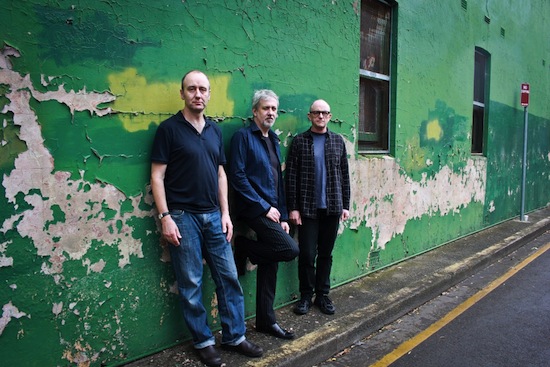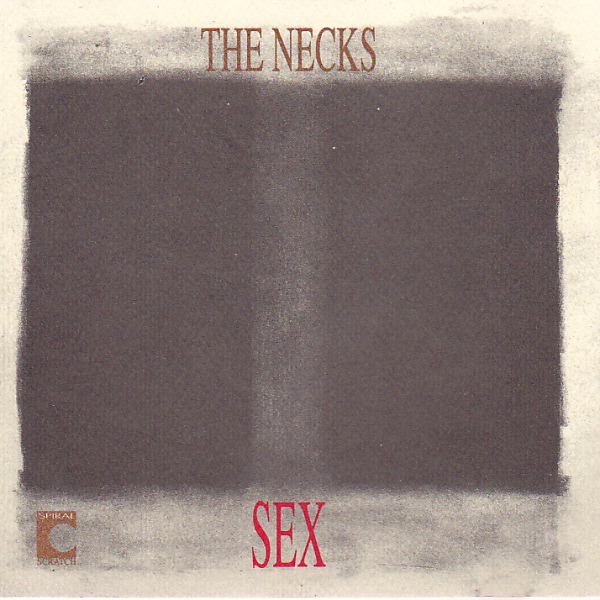Piercing the darkness and din, over her drink, were my sister’s eyes, insisting I meet their glare. I’d done it, just before, and it had been horrible. She was in hell over there on her high swivel stool and was blaming me.
Around that time – 2003-ish – I maxed out on seeing The Necks live. I certainly stopped bringing friends and family. The gig with my sister was at a small venue called The Basement, and particularly full on, but any Necks’ show is a make or break experience. Some find it cathartic, others buckle and ever the twain shall chafe in the washout.
The trio’s routine is to play two improvised sets using just piano, double bass and drums: one set relatively calm; the other dispensing sound of escalating intensity for a long hour. Jazz by name but not by nature – if jazz denotes songs that spark at intervals into fine displays of musicianship and tricky timing, after which one claps, drinks, and feels pretty good about the world and the talent in it. No, The Necks plunge listeners to the kinds of violent psychological depths few other bands can achieve at all, let alone all acoustically. A decade passed before I again chanced a show with a Necks neophyte, in March at the Sydney Opera House. When he recovered his power of speech, he said something like "best gig ever".
Not that my conversion rate mattered anymore. The trio no longer needed devotees like me to evangelise their cause and hadn’t for a long time. During the 90s and early 2000s, however, The Necks’ arses-on-seats following remained of cultish size and sentiment, its growth largely due to word-of-mouth proselytising spurred by the experience of seeing them live. Until I saw hundreds filling the Opera House and, after the show, waiting in reverent silence for several beats before clapping – part of The Necks’ live ritual – I was stuck in yesteryear, still spreading the word, even though most people I told already knew.
Yet in the 25 years since their debut record, Sex, The Necks’ music had grown more obtuse. There was no crossover album to rope people in, though their soundtrack for ultra-disturbing film The Boys (1998) certainly raised their profile in Australia. Ultimately, the world crossed-over to The Necks, not vice versa, making their ascension a study in gradual, intuitive, creative integrity. Just like a Necks record.
The trio of Chris Abrahams (piano), Lloyd Swanton (bass) and Tony Buck (drums and percussion) formed in Sydney in 1987. They recorded Sex soon after though its release waited until 1989. "The CD format arrived just in time for us … it would have been tragic to cut a piece in half to fit it across both sides of an LP," Swanton told All About Jazz. For the next 22 years The Necks’ records were released solely on CD, a format Abrahams has said "was the only true medium for us", allowing the opportunity to record and commercially release lengthy uninterrupted tracks. The Necks first vinyl release wasn’t until 2011 with Mindset.
Sex doesn’t fulfil first album stereotypes. It is fully formed and unfaltering, as smooth and lustrous as sea-lashed glass. Neither is it a raw prototype of the trio’s future sound, as many debut records are. More placid and predictable than later albums, it breaks over you, hypnotic and wave-like, for nearly an hour. There are moments when Swanton’s bass pitches towards portent but no sooner does the tension tighten than it is loosened by Abrahams’ returning piano motifs – as warm and constant as late afternoon sun. Recorded simply as a studio jam followed by overdubs and mixing, this first Necks record was presumably the one that pleased the jazz purists, lacking the experimental and electronic flourishes that followed.
Even in retrospect, Sex offers no discernable commentary on the late 80s. Perhaps this is because, astonishingly, in 1989 the three men were resolved to play only in private, free of audience expectations and the answering call to fulfil them. That resolve dissipated but the inwardness of The Necks’ inception remained, most notably in the meditative nature of their compositions. Not always tranquil meditations, of course, and dogged by paranoia, anxiety and a nameless feeling something is not quite right. But what could be more of the self than fears such as these? Meditative music that glosses over fear presents only half the journey of the inward-facing eye.
Sex is not my favourite release by The Necks but I’ve played it more than any other album I own. Contrary to its suggestive title, I play it to work. Entirely absorbing and never distracting, it spins me into an ambient cocoon in which I can write. I "used" it daily when working at a buttoned-up, blue chip writing agency – slipping the CD case under the edits littering my desk to avoid explanations. I’ve used it so long and so successfully I induce my own Pavlovian desire to focus when I hear it. And I’m not the only one. Visual artists play it to paint. Swanton used it constantly to settle his first baby. According to a feature on the trio by Tony Mitchell of Cyclic Defrost, it is popular in birthing centres. Sex settles into its own skin, immediately, and stays there. There’s no build-up or climax. Ironically.

During the naughties The Necks oozed from cult to iconic band, both at home in Australia and abroad. Copies of Sex, originally released on Spiral Scratch, re-issued in ’95 on The Necks’ label Fish Of Milk and, more recently, on Fuse, continued to tick over. In 2001 and 2002 the band added America and Canada to their European tour circuit, which paid off later when a New York Times reviewer called them "one of the greatest bands in the world". They won Australian Recording Industry Association awards for Drive By in 2003 and Chemist in 2006 and though they continued to play jazz venues and festivals the trio was embraced within experimental music too, playing with Radian and Pan American in 2006 and at Unsound Festival in 2008. In 2009, they played the Nick Cave-curated ATP festival and at Brian Eno’s Pure Scenius evenings.
The racket The Necks were capable of cooking up was given a tacit nod by their support slot for Swans’ Australian tour in 2011. In 2012 Aether was added to the National Film And Sound Archive’s Registry of Recorded Sound for its "particular significance". And always, an aftermath of glowing reviews trailing their shows like a comet’s tail. International acclaim aside, Abrahams said in a Cyclic Defrost interview last year that "The Necks could only come from Sydney" due to the "intuitive" and "very physical" jazz scene he was part of in his youth. In a city that often feels overshadowed by the quality and quantity of music from Melbourne, it’s reassuring to know The Necks could have been birthed no place else. According to Swanton, Australia’s lack of a strong jazz history also had an influence on The Necks’ innovative style. "There’s some pretty heavy boxes that have to be ticked… in the cultural centres of the northern hemisphere before you can go any further and we don’t have that." It was a thrill, too, for Sydney-siders when The Necks released a track on a split 7" this year with The Hard-Ons – legendary Sydney punk-rock thrashers celebrating their 30th anniversary. In big ways and small, they continue to surprise.
Twenty-five years on, Sex is still the trio’s best-selling release. Maybe it’s the promise of a sweet bedroom soundtrack but it’s probably because Sex is their most accessible. Though there’s been a sting in the tail for some who’ve seen The Necks play on the back of this gentle, jazzy composition, perhaps taking a ride they didn’t expect. "Our recordings inform our live improvisations but only in the most diffuse way," Swanton told me. "We would never directly quote from one of our albums." Seeing The Necks live, though, is completing the circle and fortunately they tour often and comprehensively, re-visiting old haunts and smaller venues. They’re returning to The Basement next March. I won’t be taking my sister.


